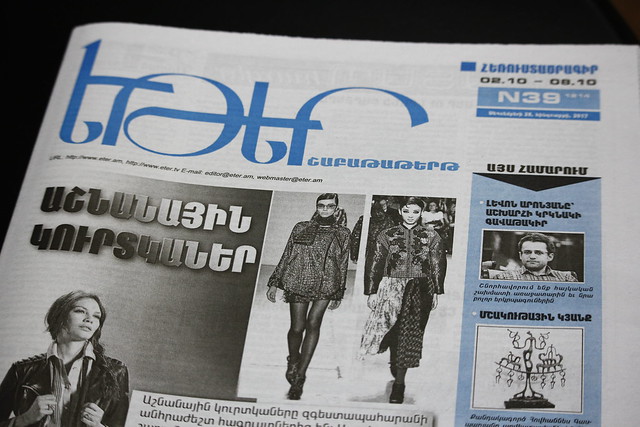Alongside the spread of the internet, the problems of print newspapers are increasing. It’s particularly difficult for those newspapers that don’t have a website.
Two of independent Armenia’s most read newspapers, Futbol+ and Yeter, are trying to find new solutions not to lose readers.
Futbol+’s first issue was published in 1996, and in a short period of time the newspaper’s circulation reached 12,000. This is stated by the weekly paper’s founder and chief editor, Suren Baghdasaryan. “When Futbol+ was founded, there was no other sports newspaper. The newspaper even had its own two correspondents in France: Aharon Boyajyan and Grigor Amirzayan. Then a few other sports newspapers began to be printed, but only our paper stood the test of time.”
These days, Futbol+ has problems. Its circulation has dropped down to 6,000 copies. Baghdasaryan says the newspaper’s readership are the senior and middle-age generations, who simply feel connected to the newspaper.

The paper doesn’t get any advertising orders. During the so-called good years, when they didn’t have financial problems, the chief editor didn’t want to fill the newspaper’s pages with advertisements. But now, according to Baghdasaryan, companies don’t place ads in print newspapers.
The growth of online media created a difficult situation for print newspapers. “Now within the span of a minute the world knows where Henrikh Mkhitaryan ate, with whom, and so on. I can’t compete with websites with such news today. We have to publish that with a one-week delay, and we’re no longer competitive,” says Baghdasaryan, adding that the newspaper’s revenues today hardly cover its costs. If things continue this way, the newspaper will one day stop printing.
“We now live in a period where it’s almost impossible to compete with the internet. But I feel sorry to shut the paper down. For 22 years, it was the chronicler of Armenian football; no other newspaper has published as much information about Armenian football as we have,” he says.
Baghdasaryan and his team are trying to keep the circulation numbers steady thanks to exclusive pieces, which you won’t find on sports websites. For example, recently the newspaper covered so-called forgotten footballers, who are talented but haven’t achieved great successes in sports terms .
Baghdasaryan finds that Armenian sports sites are not a competitor to the weekly newspaper in terms of quality. On the flip side, the newspaper cannot be a competitor to the sites — in terms of promptness.
Newspaper journalist, photo correspondent Davit Martirosyan is publishing announcements on YouTube of interviews with this or that football player and sharing them online days before the newspaper goes to print, informing readers they can expect an interesting article in the upcoming issue. And with the goal of competing with online media in terms of speed, the journalist uploads videos on the newspaper’s YouTube channel: press conferences, interviews, goals, reviews of matches, and so on.
Baghdasaryan says that the announcements and exclusive pieces help to maintain circulation numbers. As a result, the newspaper’s return is about 17–18%, which, according to the chief editor, is not bad. The videos, on the other hand, don’t help newspaper sales.
At Futbol+, they are working toward developing their future website. They’ve already digitalized all the newspaper’s issues.

Yeter and the Russian-language Efir weekly newspapers are the longest-running publications in the Republic of Armenia. Findings from a 2002 IREX ProMedia Armenian Sociological Association survey found that Yeter, at 27.5%, was at the top of a list of readers’ preferences. The newspaper’s circulation was 60,000 at the time. Today this number has dropped several times, but again it remains one of the most sold newspapers.
Yeter managing editor Gayane Yengoyan says that the circulation drop is due to several factors: population decline, competitors, and of course, the internet.
“According to our observations, Yeter’s main readers are the elderly, and they pick up the newspaper not so much for the TV program as for the interesting pieces within its pages. We have youth and children’s pages. The work of the youth page has become quite active; mainly students are involved in this. The students undergo training at Yeter; they get published,” says Yengoyan.
For several years in a row, several dozen ads were printed at once in each issue of the newspaper. Now business communities prefer to place ads on television, radio, and online media, or take advantage of outdoor advertising opportunities.
Yengoyan believes that having an online version of the newspaper is inevitable in terms of development in this century. This way it will also be possible to attract advertisers.
Gagik Aghbalyan







